Abstract
The present study describes the distribution of Veillonella and Neisseria species in the human oral cavity and indicates that their ability to attach to oral surfaces correlates with their proportions found in various sites of the mouth. The mean percentages of Veillonella and Neisseria of the total flora cultivable on anaerobic blood-agar plates was found to be: plaque, 0.75 and <0.13, respectively; lip, 0.38 and <0.05; cheek, 0.66 and <0.14; tongue dorsum, 9.4 and <0.12; saliva, 5.0 and <0.9. The ability of Veillonella and Neisseria species to attach to tooth surfaces was studied by cleaning the labial surfaces of incisors to render them relatively free of viable bacteria. Samples taken 1 hr later contained <0.27% Veillonella and <0.4% Neisseria, whereas saliva to which these teeth were exposed contained 20-fold higher proportions of Veillonella. These data indicate that Veillonella and Neisseria species possess a feeble ability to attach to cleaned teeth. The ability of these organisms to adhere to other oral surfaces was determined by introducing mixtures of streptomycin-resistant strains into the mouths of volunteers for 5 min. Labeled strains of Streptococcus sanguis and S. salivarius were included for comparative purposes. Analysis of samples obtained from oral surfaces after 45 min indicated that Veillonella and Neisseria adhere very poorly to preformed dental plaque as compared to S. sanguis. In contrast, Veillonella adhered to the tongue dorsum markedly better than Neisseria, S. sanguis, and S. salivarius. The greater ability of Veillonella to adhere to the tongue in relation to the other organisms studied correlates with the high proportions of Veillonella found on this site. The feeble ability of Neisseria to attach to surfaces in the oral cavity is reflected by their low proportions found on these surfaces.
Full text
PDF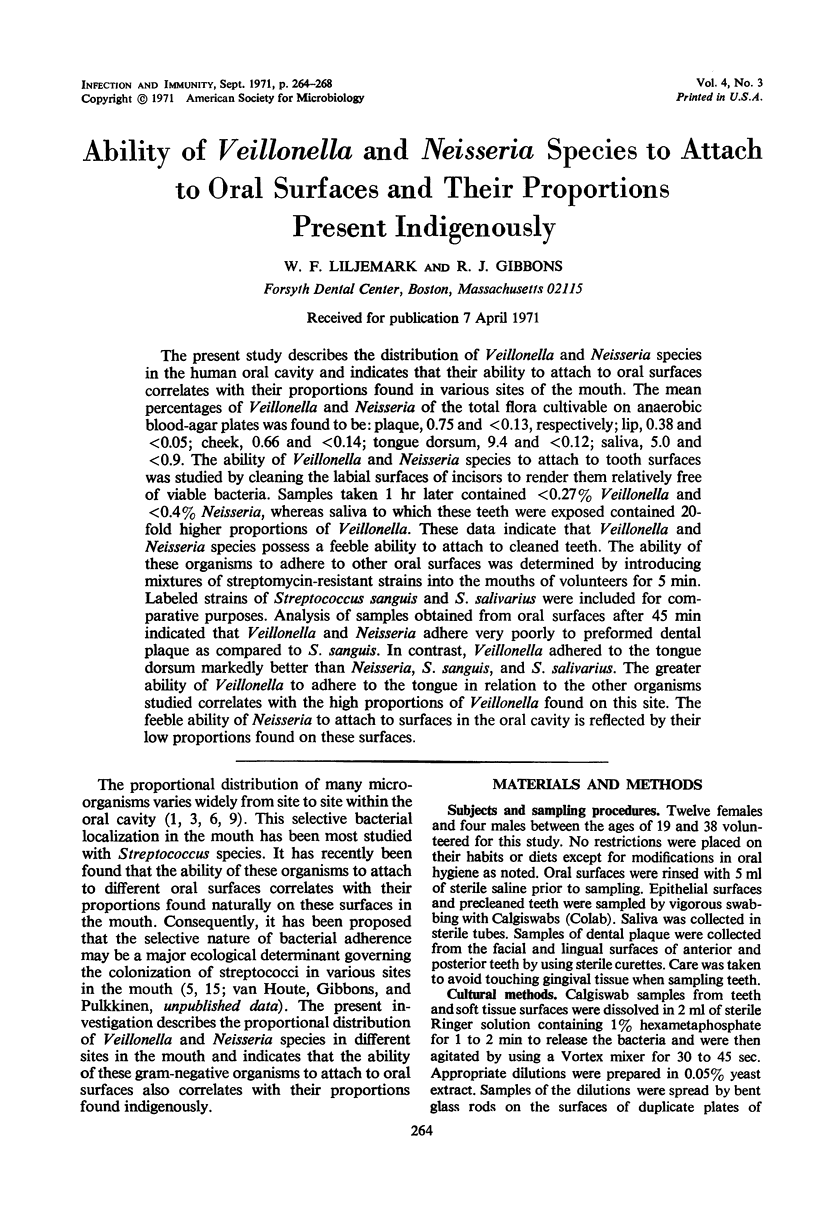
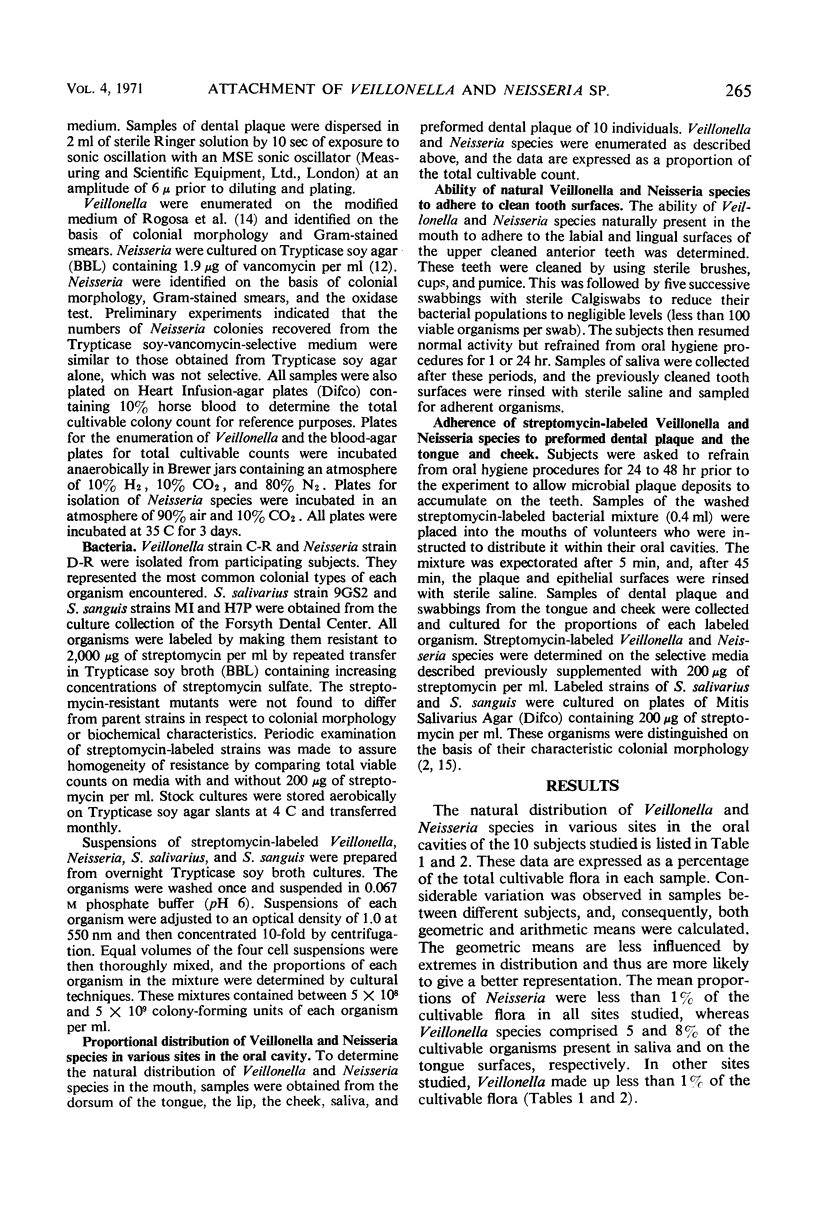
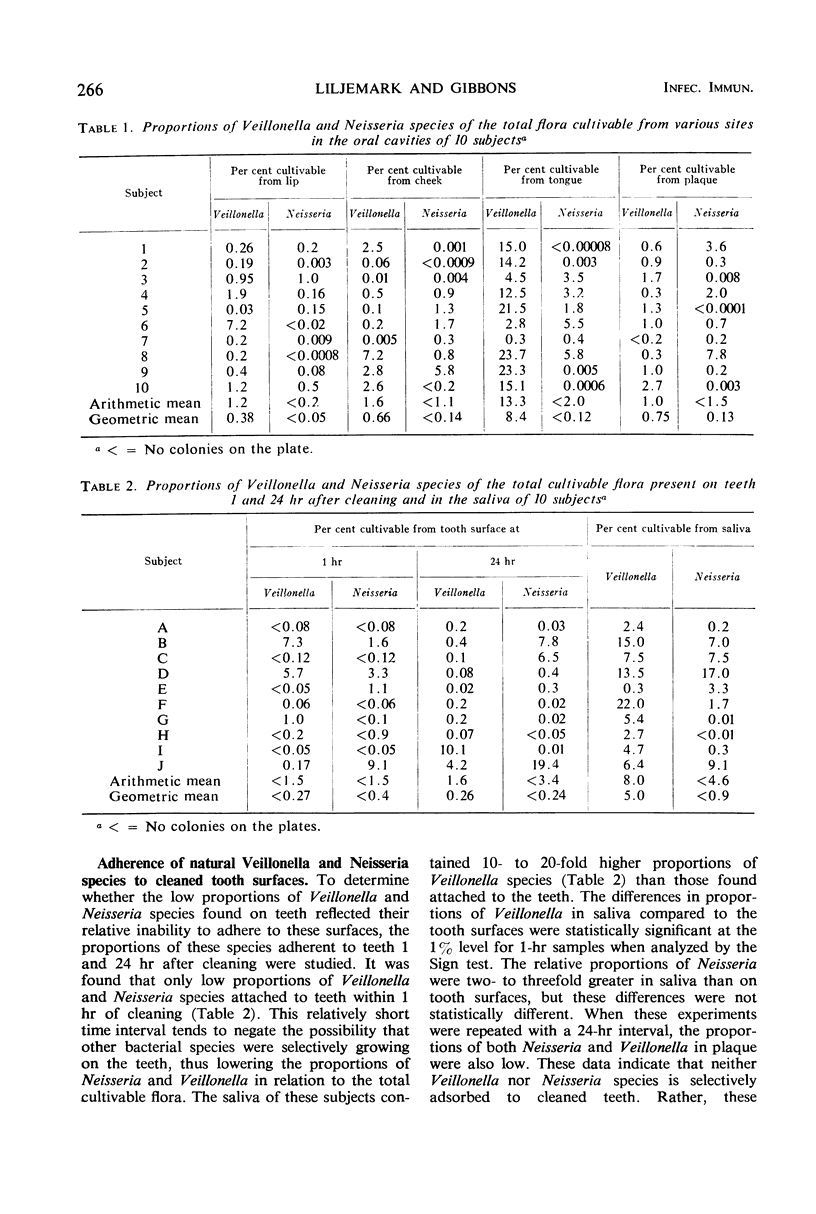
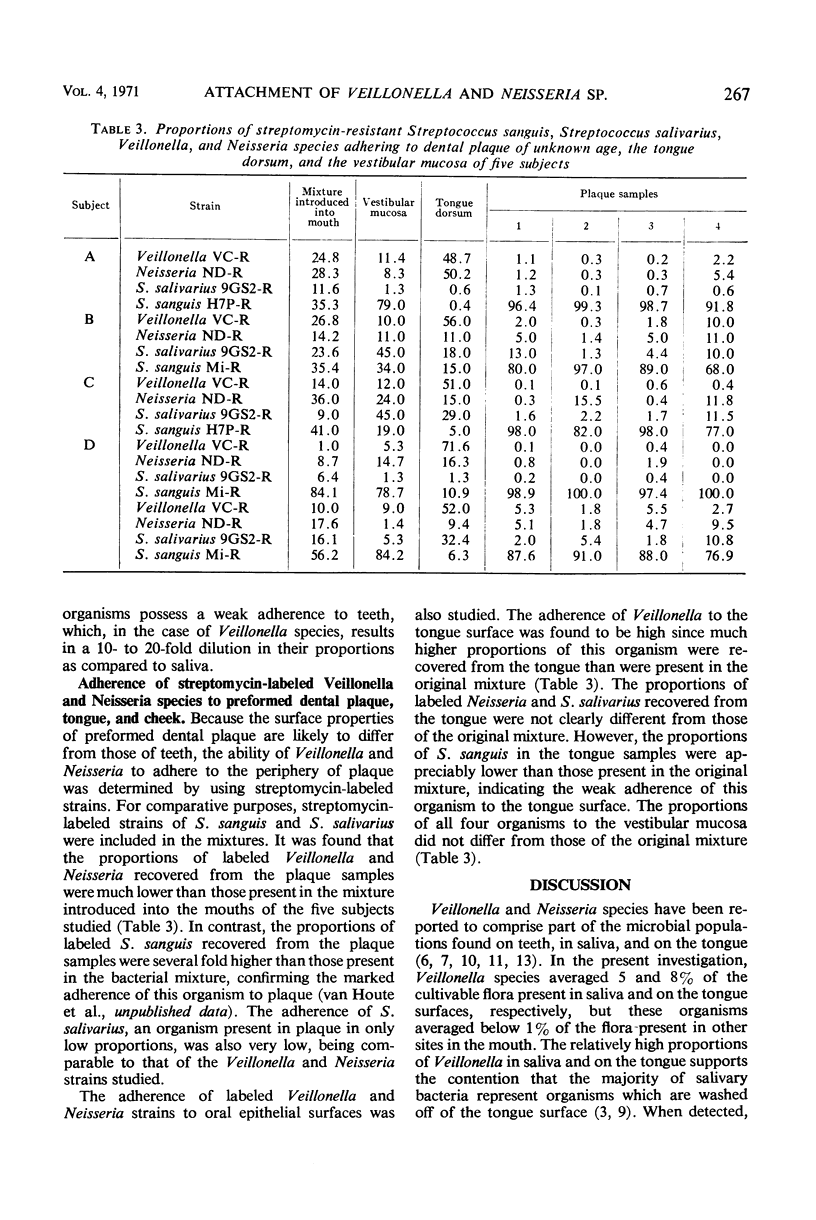
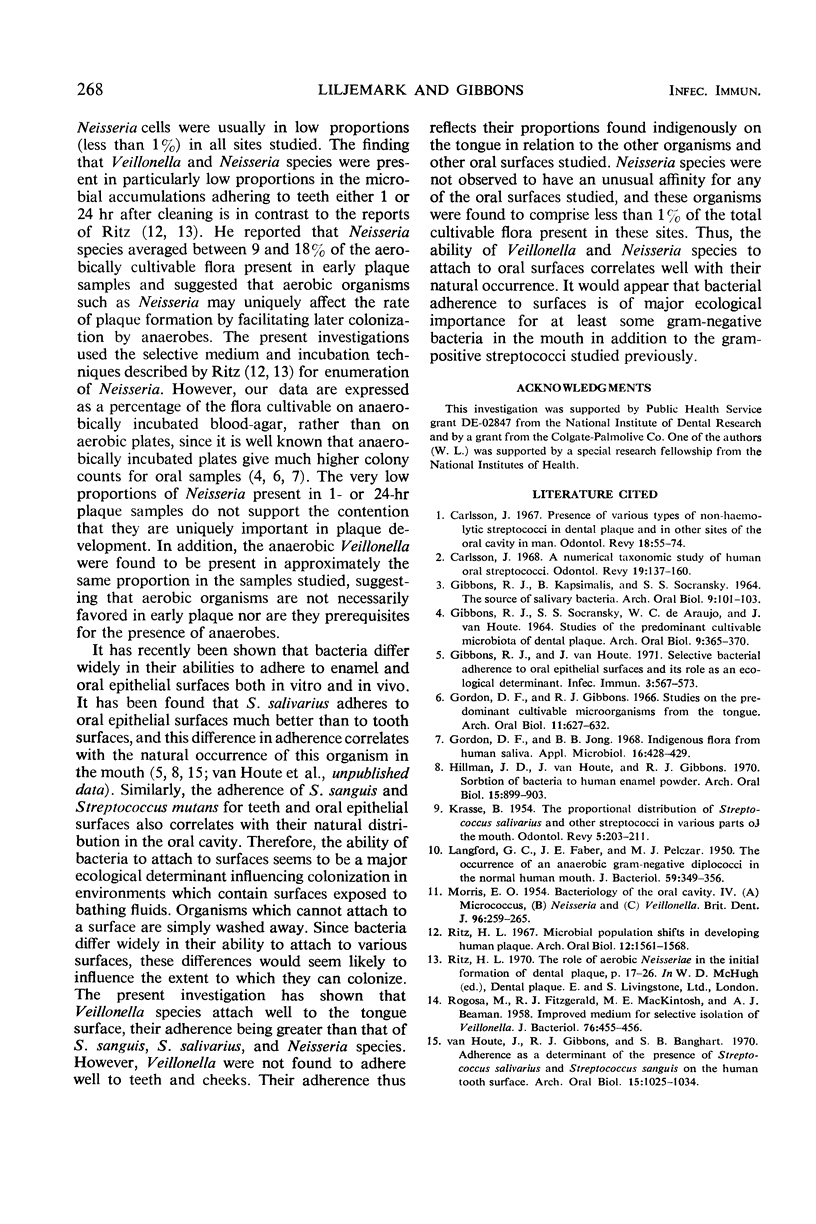
Selected References
These references are in PubMed. This may not be the complete list of references from this article.
- Carlsson J. A numerical taxonomic study of human oral streptococci. Odontol Revy. 1968;19(2):137–160. [PubMed] [Google Scholar]
- Carlsson J. Presence of various types of non-haemolytic streptococci in dental plaque and in other sites of the oral cavity in man. Odontol Revy. 1967;18(1):55–74. [PubMed] [Google Scholar]
- GIBBONS R. J., KAPSIMALIS B., SOCRANSKY S. S. THE SOURCE OF SALIVARY BACTERIA. Arch Oral Biol. 1964 Jan-Feb;9:101–103. doi: 10.1016/0003-9969(64)90052-4. [DOI] [PubMed] [Google Scholar]
- GIBBONS R. J., SOCRANSKY S. S., DEARAUJO W. C., VANHOUTE J. STUDIES OF THE PREDOMINANT CULTIVABLE MICROBIOTA OF DENTAL PLAQUE. Arch Oral Biol. 1964 May-Jun;9:365–370. doi: 10.1016/0003-9969(64)90069-x. [DOI] [PubMed] [Google Scholar]
- Gibbons R. J., van Houte J. Selective bacterial adherence to oral epithelial surfaces and its role as an ecological determinant. Infect Immun. 1971 Apr;3(4):567–573. doi: 10.1128/iai.3.4.567-573.1971. [DOI] [PMC free article] [PubMed] [Google Scholar]
- Gordon D. F., Jong B. B. Indigenous flora from human saliva. Appl Microbiol. 1968 Feb;16(2):428–429. doi: 10.1128/am.16.2.428-429.1968. [DOI] [PMC free article] [PubMed] [Google Scholar]
- Gordon D. F., Jr, Gibbons R. J. Studies of the predominant cultivable micro-organisms from the human tongue. Arch Oral Biol. 1966 Jun;11(6):627–632. doi: 10.1016/0003-9969(66)90229-9. [DOI] [PubMed] [Google Scholar]
- Hillman J. D., Van Houte J., Gibbons R. J. Sorption of bacteria to human enamel powder. Arch Oral Biol. 1970 Sep;15(9):899–903. doi: 10.1016/0003-9969(70)90163-9. [DOI] [PubMed] [Google Scholar]
- KRASSE B. The proportional distribution of Streptococcus salivarius and other streptococci in various parts of the mouth. Odontol Revy. 1954;5(3):203–211. [PubMed] [Google Scholar]
- LANGFORD G. C., Jr, FABER J. E., Jr, PELCZAR M. J., Jr The occurrence of anaerobic gram-negative diplococci in the normal human mouth. J Bacteriol. 1950 Mar;59(3):349–356. doi: 10.1128/jb.59.3.349-356.1950. [DOI] [PMC free article] [PubMed] [Google Scholar]
- ROGOSA M., FITZGERALD R. J., MACKINTOSH M. E., BEAMAN A. J. Improved medium for selective isolation of Veillonella. J Bacteriol. 1958 Oct;76(4):455–456. doi: 10.1128/jb.76.4.455-456.1958. [DOI] [PMC free article] [PubMed] [Google Scholar]
- Ritz H. L. Microbial population shifts in developing human dental plaque. Arch Oral Biol. 1967 Dec;12(12):1561–1568. doi: 10.1016/0003-9969(67)90190-2. [DOI] [PubMed] [Google Scholar]
- Van Houte J., Gibbons R. J., Banghart S. B. Adherence as a determinant of the presence of Streptococcus salivarius and Streptococcus sanguis on the human tooth surface. Arch Oral Biol. 1970 Nov;15(11):1025–1034. doi: 10.1016/0003-9969(70)90115-9. [DOI] [PubMed] [Google Scholar]


